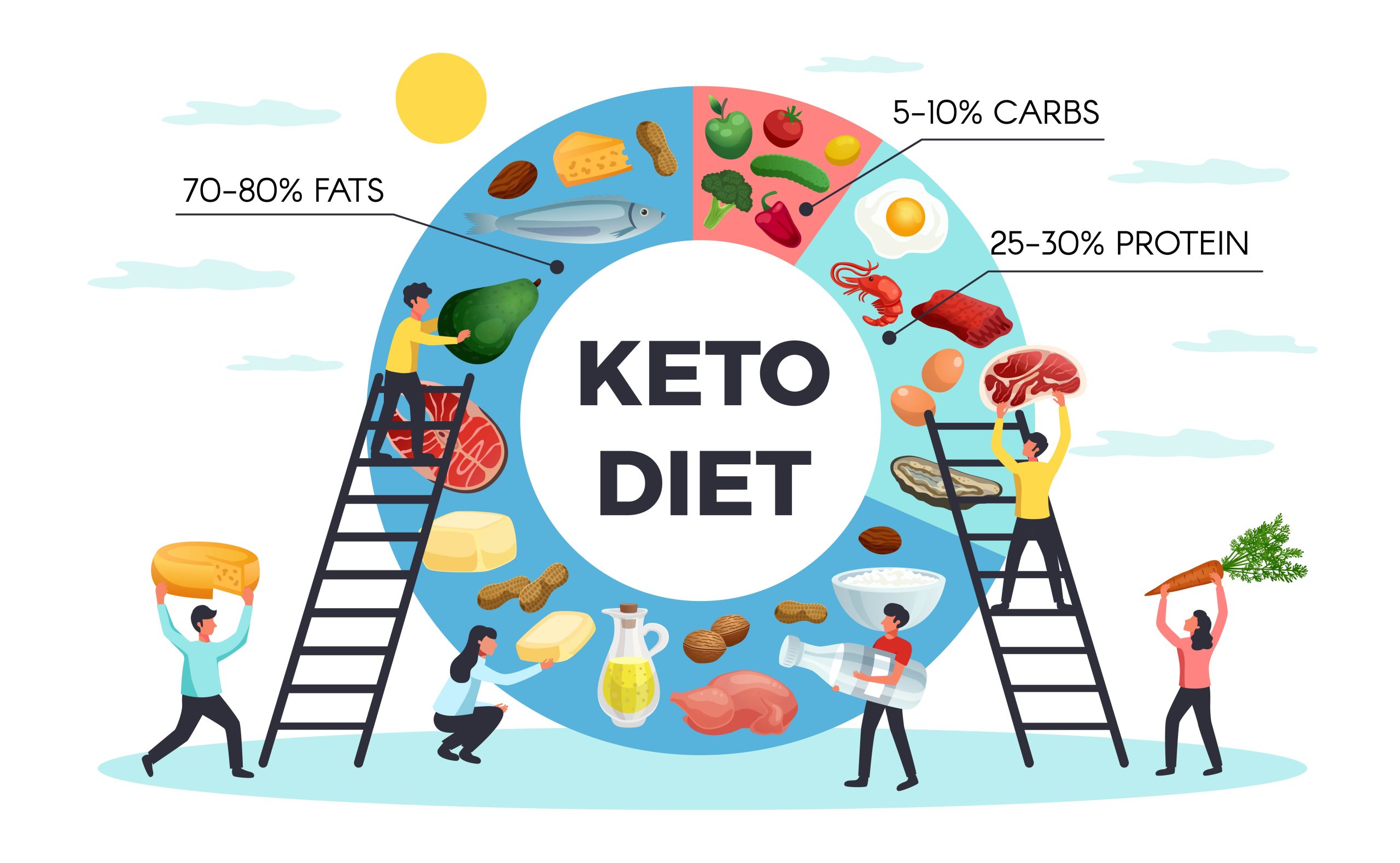A Detailed Beginner’s Guide to Keto

The keto diet, short for ketogenic diet, is a high-fat, low-carbohydrate eating plan that has gained popularity in recent years for its potential health benefits. By drastically reducing carb intake and replacing it with fats, the body enters a state of ketosis, where it burns fat for fuel instead of glucose. This can lead to weight loss, improved blood sugar control, and enhanced mental clarity for some individuals.
A Detailed Beginner’s Guide to Keto offers a comprehensive overview of how to successfully navigate the complexities of starting and maintaining a keto lifestyle. From calculating macros and meal planning to understanding the science behind ketosis, this guide covers all the essential information needed to kickstart your journey towards better health and vitality on the keto diet.
Next, we will delve into the specifics of what foods to eat and avoid on the keto diet, along with tips for staying on track and troubleshooting common challenges that beginners may face. Additionally, we will explore the benefits of incorporating intermittent fasting with keto for even greater results, as well as provide practical advice on how to ease into the diet gradually for long-term success.
- The keto diet is a high-fat, low-carb eating plan that focuses on drastically reducing carbohydrate intake and replacing it with healthy fats.
- The primary goal of the keto diet is to achieve a state of ketosis, where the body shifts from using glucose as its primary fuel source to using stored fats for energy.
- To get started on the keto diet, individuals should calculate their macronutrient ratios, typically aiming for 70-75% fat, 20-25% protein, and 5-10% carbohydrates.
- Foods to prioritize on the keto diet include avocados, olive oil, fatty fish, nuts, seeds, and low-carb vegetables, while foods to avoid include grains, sugars, starchy vegetables, and most fruits.
- Common side effects of starting the keto diet may include the “keto flu,” which can cause symptoms like fatigue, headache, and irritability, but these can be managed by staying hydrated, increasing electrolyte intake, and gradually transitioning into ketosis.
- The keto diet has shown promising results for weight loss, improved blood sugar control, increased energy levels, and mental clarity, but it may not be suitable for everyone, especially those with certain medical conditions or dietary restrictions.
- It is essential to listen to your body, monitor your progress, and make adjustments as needed to ensure that you are getting the right balance of nutrients and staying healthy while following the keto diet.
What is the Keto Diet and How Can Beginners Get Started?
When embarking on a journey to adopt the keto diet, it’s essential to understand some key terms that are frequently used within the keto community. Firstly, ketosis refers to the metabolic state in which the body burns fat for fuel instead of carbohydrates. Macros, short for macronutrients, are the three main components of the keto diet: fats, proteins, and carbohydrates. Tracking macros involves monitoring the intake of these nutrients to ensure they are within the desired ratio for achieving and maintaining ketosis. Electrolytes are minerals such as sodium, potassium, and magnesium that are important for maintaining proper hydration and muscle function while on the keto diet.
Before diving into the world of the keto diet, it’s crucial to understand the basics of what it entails. The ketogenic diet is a high-fat, moderate-protein, and low-carbohydrate eating plan that aims to put the body into a state of ketosis. In ketosis, the body switches from using carbohydrates as its primary source of energy to using fats. This shift in metabolism can lead to weight loss, improved mental clarity, and increased energy levels. By drastically reducing carb intake and increasing fat consumption, individuals can retrain their bodies to burn fat more efficiently. With a variety of delicious and satisfying foods to choose from, the keto diet can be both enjoyable and sustainable for beginners looking to improve their overall health and well-being.
Benefits of Low-Carb Diets
One popular option for achieving weight loss and health goals is following a low-carb diet. These types of diets can help improve blood sugar control, reduce inflammation, and promote weight loss. Some of the benefits of low-carb diets include increased energy levels, improved mental clarity, and reduced cravings for sugar and processed foods. Many people find that they also experience better digestion and fewer mood swings when following a low-carb eating plan.
High-Fat Diets for Athletic Performance
For those looking to optimize their athletic performance, a high-fat diet may be a suitable option. By increasing fat intake and reducing carbohydrates, many athletes have reported improvements in endurance, quicker recovery times, and enhanced lean muscle mass. High-fat diets can also support long-term energy levels during endurance activities, as fat is a more sustained fuel source compared to carbohydrates. Some athletes may even choose to incorporate periods of fasting or ketosis into their training regimen to further enhance their performance.
Vegan and Vegetarian Alternatives
While the keto diet typically consists of high-fat, moderate-protein, and low-carb foods, there are vegan and vegetarian alternatives that can achieve similar results. Instead of relying on animal products for fat and protein sources, individuals following a plant-based keto diet may consume foods like avocados, coconut oil, nuts, seeds, and plant-based protein sources. These diets can still promote weight loss, improve blood sugar control, and provide the benefits of ketosis without the consumption of animal products. Vegan and vegetarian keto diets may also be more sustainable and environmentally friendly compared to traditional keto diets.
1. What is the keto diet and how does it work?
The keto diet, short for ketogenic diet, is a high-fat, low-carbohydrate eating plan that has been shown to be effective for weight loss and improved overall health. When you limit your intake of carbs, your body enters a state of ketosis, where it burns stored fat for energy instead of glucose from carbs. This can lead to rapid weight loss and increased energy levels.
2. Is the keto diet safe for beginners?
While the keto diet can be safe for most people, it is important to consult with a healthcare professional before starting any new eating plan, especially if you have any underlying health conditions. It is also important to make sure you are getting a balance of nutrients while on the keto diet, so be sure to incorporate a variety of healthy fats, proteins, and vegetables into your meals.
3. What foods are allowed on the keto diet?
On the keto diet, you should focus on eating high-fat foods such as avocados, nuts, seeds, and olive oil, as well as protein sources like meat, fish, and eggs. You should also limit your intake of carbohydrates, so avoid starchy vegetables, grains, and sugars. Instead, opt for low-carb vegetables like leafy greens, broccoli, and cauliflower.
4. What are some common side effects of the keto diet?
Some common side effects of the keto diet include the keto flu, which can cause symptoms like fatigue, headache, and irritability as your body adjusts to burning fat for fuel instead of carbs. You may also experience constipation or bad breath, which can be alleviated by drinking plenty of water and eating fiber-rich foods. It is important to listen to your body and make adjustments to your diet as needed.
5. How can I make sure I am staying in ketosis?
To ensure you are staying in ketosis, it is important to track your macronutrient intake and keep your carb intake low, typically around 20-50 grams per day. You can also use ketone test strips to check your ketone levels and make sure you are in ketosis. Additionally, regular exercise can help boost ketone production and keep you in ketosis.
6. Can I drink alcohol on the keto diet?
While some alcoholic beverages are low in carbs and can be consumed in moderation on the keto diet, it is important to be mindful of your alcohol intake as it can slow down weight loss and affect ketosis. Stick to low-carb options like dry wine, spirits, or light beer, and be sure to account for the carbs in your overall daily intake.
7. What are some tips for meal planning on the keto diet?
When meal planning on the keto diet, focus on incorporating a variety of healthy fats, proteins, and low-carb vegetables into your meals. Batch cooking and meal prepping can help save time and keep you on track with your eating plan. Be sure to have keto-friendly snacks on hand to avoid temptation and stay satisfied throughout the day.
8. How long does it take to see results on the keto diet?
While everyone’s body is different, many people report seeing results on the keto diet within a few weeks of starting the plan. Weight loss may vary depending on individual factors such as metabolism, activity level, and adherence to the diet. It is important to be patient and consistent with your eating plan to see long-term results.
9. Can I practice intermittent fasting with the keto diet?
Intermittent fasting, which involves cycling between periods of eating and fasting, can be combined with the keto diet to enhance weight loss and other health benefits. Pairing intermittent fasting with keto can help increase ketone production and fat burning. However, it is important to listen to your body and consult with a healthcare professional before starting any new eating plan.
10. Are there any supplements that can help support the keto diet?
While it is possible to get all the necessary nutrients from whole foods on the keto diet, some people may benefit from taking supplements to support their health and weight loss goals. Common supplements for the keto diet include electrolytes, omega-3 fatty acids, and magnesium. Be sure to consult with a healthcare professional before starting any new supplements to ensure they are safe and appropriate for your individual needs.
Final Thoughts
- Understanding the basics of the keto diet is crucial for beginners looking to embark on this lifestyle change.
- It is essential to focus on consuming high-fat, moderate protein, and low-carb foods to achieve ketosis.
- Tracking macronutrients and staying hydrated are key factors in successfully following the keto diet.
- Meal planning and preparation can make it easier to adhere to the restrictions of the keto diet.
- Supplementing with electrolytes can help prevent the “keto flu” symptoms during the initial stages of transitioning to keto.
- Consulting with a healthcare professional before starting the keto diet is recommended, especially for individuals with underlying health conditions.
- Being patient and allowing your body to adapt to the keto diet is essential for long-term success.
In conclusion, the keto diet offers numerous health benefits, including weight loss, improved energy levels, and mental clarity. By following the guidelines outlined in this beginner’s guide to keto, you can embark on this journey with confidence and achieve your health and wellness goals.






